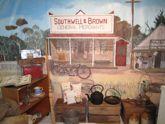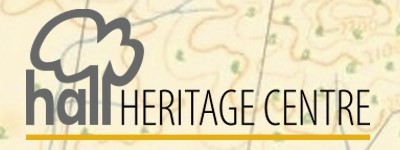Database: Early Capital Region Government Schools and Teachers
A database created by the Hall Heritage Centre to record and make accessible the early history of public schooling in the Canberra district. There are currently entries for over eighty schools, and more than 600 teachers, illustrated by 400 photographs, maps, plans etc.
- Click a 'blackboard' icon on the map below to select a school, or select from the list of school names just below the map.
- All Teachers are listed alphabetically, and teachers for each school are also listed with that particular school entry.
Viewers are warmly invited to contact us with any comments, questions - or contributions.
The database is designed to tell the stories of the early public schools of the Canberra district and their teachers, and the families and communities they served. New material is being added all the time, validated to the best of our ability. It is our hope that users will be prompted to make contributions, and advise us when errors or omissions are found.
The first such schools had opened in 1850, and by the time the city of Canberra was officially named in 1913 many of them had already closed. Before the first 'modern' Canberra school opened in 1923 (Telopea Park School), a handful of other 'temporary' schools were established to meet the educational demands of a growing workforce (eg. Acton, Russell Hill, Molonglo, Cotter).
Sutton and Gundaroo schools are still operating. Within the ACT the last two - Hall and Tharwa - were closed in 2006. Only a few of the early buildings remain - one (Gungahleen) in replica. Many former school sites are obscure, and forgotten. A few of them are commemorated with plaques. All of them, however, have considerable significance amongst the families and communities they served, or whose forbears were teachers in them.
Alphabetical listing of schools
More than eighty schools are currently listed (2022), and around 600 teachers who taught at these schools. Further early schools of the Canberra district will be added progressively. If you have information about such a school that you would like to see added please use the links at the bottom of this page to let us know.
In addition to the information on this site the Hall Heritage Centre has research files on around half of these schools, and a good deal of additional information about most of them. You are warmly invited to visit and make use of this resource.
- Acton school
- Amungula
- Argyle Cutting
- Barnes Creek school
- Bedellick
- Berebangalo
- Boambolo
- Bobeyan (Tin Dish) School
- Brooklands
- Brooks Creek
- Bywong
- Canberra School
- Captain's Flat
- Carwoola
- Cavan
- Chain of Ponds
- Church Rock Valley School
- Cotter River School
- Creekborough
- Dalton Public School
- Derringullen
- Duntroon School
- Elizabethfield School
- Euralie
- Fell Timber School/Kohan
- Flannel Tree School
- Foxlowe
- Gibraltar School
- Ginninderra School
- Glenwood
- Gooda Creek
- Good Hope
- Googong
- Gundaroo
- Gundarooo Upper
- Gungahleen School
- Hall School
- Jeir Public School
- Kowen School
- Ledgerton
- Majura School
- Malcolm Vale
- Michelago
- Molonglo School
- Mugwill School
- Mulligans Flat School
- Mundoonan Aboriginal School
- Murrumbateman School
- Murryong subsidised school
- Naas School
- Nanama (Griffiths Flats)
- Narrabundah ('Crossroads') School
- Narrangullen
- Nelanglo
- Nerrabunda ('Long Gully') School
- New Bristol school
- Parkwood
- Peak View
- Queanbeyan Public School
- Royalla School
- Russell Hill School
- Shannons Flat
- Stone Hut School
- Sutton Public School
- Tallagandra School
- Tarago Public School
- Tharwa School
- The Mullion
- Thornhurst School
- Tirranna Public School
- Toual
- Tuggeranong School
- Upper Naas School
- Uriarra School
- Wallaroo
- Wantagong
- Wargeila Public School
- Warham
- Wee Jasper
- Weetangera School
- Williams Creek
- Williamsdale School
- Wyanga
- Yarra
- Yarralumla ('Bulgar Creek')
- Yarrowlumla
- Yass Aboriginal School
- Yass Public School
- Yumburra West
The history of schooling in the Canberra district is, until 1911, part of the history of schooling in NSW and the Department of Public Instruction. Outside the cities and towns this was a story of one-teacher 'bush' schools provided in response to petitioning from groups of parents, but closed when populations dwindled. This database encompasses both NSW and Canberra schools of the Capital Territory region.
A decade after creation of the Commonwealth of Australia (January 1st 1901), a site for the Federal capital was determined and the Federal Capital Territory proclaimed (January 1st 1911). 2,360 square kilometres was ceded by the State of New South Wales for this purpose. While this land was only lightly settled, it contained fourteen one-teacher 'bush schools', located where the settlers were most closely gathered - along the rivers and creeks, and on the better agricultural land.
Schools might be 'House-to-House', 'Subsidised', 'Half-Time', 'Provisional', or 'Public', depending mainly on the number of students attending. Not only the status of schools, but also their names and locations might change over time. There was often both a 'local' name and an official name; schools were often superseded by a new school building on a different site - or conveyed to a site closer to concentrations of families sending children. The entries for the schools listed here seek to record both the official history of the school and it's place amongst the families and communities who lobbied to get it, often built it themselves, sent their children, provided lodgings for the teachers, and celebrated it's milestones.
If you are able to assist our work of identifying, documenting, and celebrating the early bush schools of the Canberra region, please contact us or .
If you are interested in participating in this work, you may like to become a 'Friend of the Hall Heritage Centre'.
We gratefully acknowledge Lyall Gillespie's detailed pioneering work on 'Early education and schools in the Canberra Region' (1999), and State Records NSW which holds and gives access to government files on NSW schooling. Our project on 'Early Canberra Schools and Teachers' was supported by an ACT Heritage Grant (2012-13).

